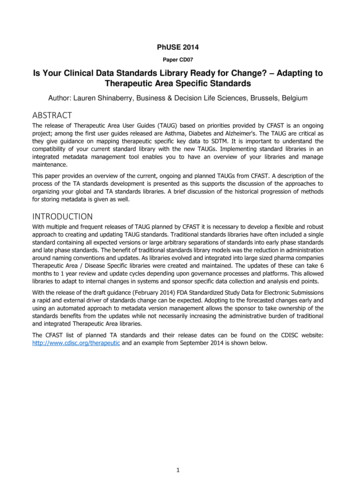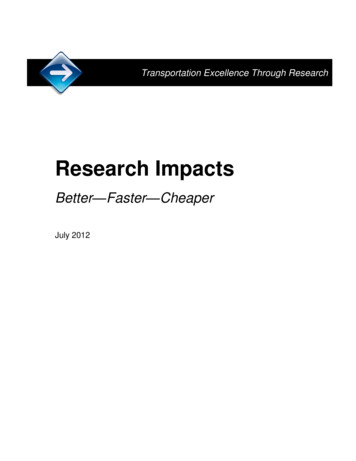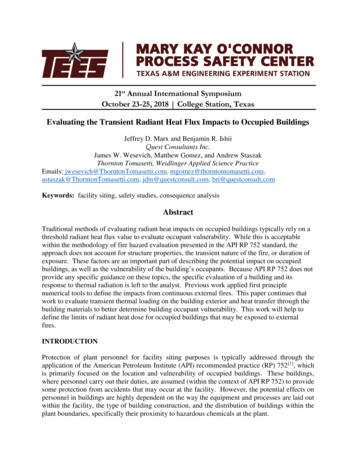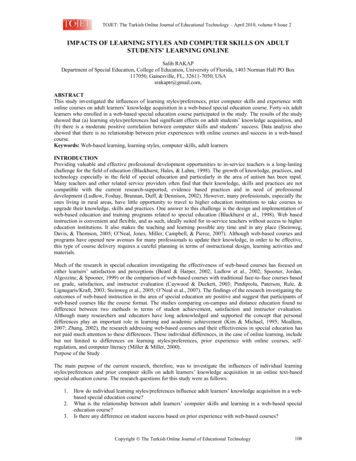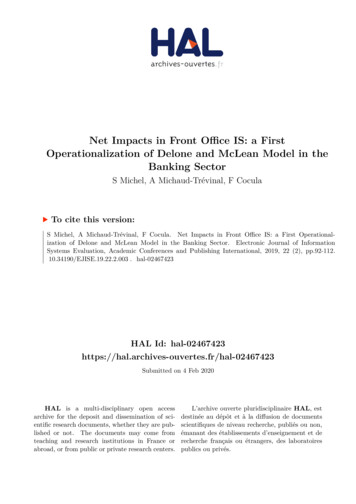
Transcription
Net Impacts in Front Office IS: a FirstOperationalization of Delone and McLean Model in theBanking SectorS Michel, A Michaud-Trévinal, F CoculaTo cite this version:S Michel, A Michaud-Trévinal, F Cocula. Net Impacts in Front Office IS: a First Operationalization of Delone and McLean Model in the Banking Sector. Electronic Journal of InformationSystems Evaluation, Academic Conferences and Publishing International, 2019, 22 (2), pp.92-112. 10.34190/EJISE.19.22.2.003 . hal-02467423 HAL Id: 2467423Submitted on 4 Feb 2020HAL is a multi-disciplinary open accessarchive for the deposit and dissemination of scientific research documents, whether they are published or not. The documents may come fromteaching and research institutions in France orabroad, or from public or private research centers.L’archive ouverte pluridisciplinaire HAL, estdestinée au dépôt et à la diffusion de documentsscientifiques de niveau recherche, publiés ou non,émanant des établissements d’enseignement et derecherche français ou étrangers, des laboratoirespublics ou privés.
Net Impacts in Front Office IS: a First Operationalization of Deloneand McLean Model in the Banking SectorSylvie Michel1, Aurélia Michaud-Trévinal2 and François Cocula11Univ. Bordeaux, IRGO,La Rochelle Université, frFrancois.cocula@u-bordeaux.fr2DOI: 10.34190/EJISE.19.22.2.003Abstract: The variable Net Impacts, a key variable in the models for information systems evaluation, is rarelyoperationalized according to a rigorous method and never for the banking sector. DeLone and McLean (2016) note that thechallenge of developing measures to evaluate information systems is still relevant. The measurement andconceptualization of variables in real contexts is both very important and relatively absent in the literature. This researchaims at operationalizing the Net Impacts construct resulting from DeLone and McLean's (2016) evaluation model forinformation systems, in the specific context of retail banks. It also aims at highlighting the socio-demographic variablesinfluencing this construct. This original work conducted with 763 people applies the Churchill paradigm (1979) to provide areliable and valid measure of Net Impacts, inspired by the Balanced Score Card. The main result of the research concernsthe empirical validation of the measure of Net Impacts. This tool consists of three categories, relating to customersatisfaction, productivity and risk and ten items, which take into account the user but also include customer perception.This three-dimensional construct shows how the information system supports the user in a wide spectrum of work. Also,by showing that in the banking field, only the function occupied by the user influences the perception of the impact of IS,we contribute to a better knowledge of the variables related to the evaluation of IS. Thus, this instrument represents astrategic tool for monitoring and guiding efforts to increase performance. The proposed instrument is very easy for CIOsand managers to use in order to evaluate their information systems with users.Keywords: Business value of IT, productivity, customer satisfaction, control, Balanced Scorecard, Banking sector, DeLoneand McLean model, Structural equation modelling.1.IntroductionThe use of computers for professional practice is now an integral part of everyday work life in organizations.Not surprisingly, the use and success of computer-based information systems has received extensive attentionfrom researchers. As early as the 1970’s, researchers tried to highlight the links between performance and ISby clearing several paths. Some have tried to show that the IS is a factor of greater productivity (Lucas, 1975;Turner, 1985; Markus and Soh, 1993; Strassman, 1997, Pashkevich and Haftor, 2014; Bui, et al., 2018). Othershave tried to highlight the impact of IS on internal processes, the value chain or the creation of a competitiveadvantage (Parsons, 1983; Ives and Learmonth, 1984; Porter and Millar, 1985; Sethi and King, 1994;Brynjolfsson and Hitt, 1996; Drnevich and Croson, 2013; Bhatt, Wang and Rodger, 2017). Still, others attemptto understand the impact of IS on organizational performance through the notion of alignment between IS andother variables such as strategy, corporate structure or environment (Ein-Dor and Segev, 1978; 1989;Henderson and Venkatraman, 1999; Shao, 2019). Much research has been devoted to IS evaluation and to ISsatisfaction (Chin and Lee, 2000; Mahmood, et al., 2000; Au, Ngai and Cheng, 2002; Vaezi, et al., 2016; Padinhaand O’Neill, 2016; Lawson-Body, et al., 2017). The heterogeneity and number of constructs used to evaluate ISor its contribution to performance are therefore very numerous. On the basis of this heterogeneity ofresearch, DeLone and McLean (1992, 2003, and 2016) proposed a synthesis in the form of a generic model thatunifies the literature. They presented the Information System Success Model (ISSM), which is now widelyaccepted throughout the scientific community as one of the main models for evaluating IS.The Net Impacts variable is one of the main variables in the IS evaluation models (DeLone and McLean, 2003,2016). These authors believe that IS-related impacts can be measured at several levels - individual,organizational and societal - and recommend that all these impacts be grouped into a single variable, netimpact. Thus, following Gable, Sedera and Chan (2008), DeLone and McLean (2016) argue that the challenge ofISSN 1566-637992 ACPILReference this paper: Michel, S., Michaud-Trévinal, A., and Cocula, F., 2019. Net Impacts in Front Office IS: aFirst Operationalization of Delone and McLean Model in the Banking Sector. The Electronic Journal ofInformation Systems Evaluation, 22(2), pp. 92-112, available online at www.ejise.com
Sylvie Michel, Aurélia Michaud-Trévinal and François Coculadeveloping measures to evaluate information systems is still relevant. In their view, the measurement andconceptualization of variables in real contexts remains particularly complex and little discussed in theliterature.The present research, which focuses on the banking sector, aims to respond to the challenges raised at bothmanagerial and academic levels. Indeed, it is crucial for banks to know how account officers perceive ISimpacts. For example, nearly 1.1 billion euros is the amount that BNP Paribas Bank is looking to invest tosupport the transformation of its Information System (IS) over the period 2017-2019. Banks, pioneers since the1980s in terms of investment in their information systems, keep investing massively in these systems today,because in the information age, front-office banking systems are perceived as the major strategic element ofvalue creation and competitiveness. Also, the evaluation of information systems remains one of their majormanagerial problems.How can the front office banking information system be evaluated, taking into account its specificities? Howcan the front office banking IS be evaluated based on the perception of the main user, the account officer? AsIS has particularly influenced the way employees execute tasks, provide customer service, and communicatewith one another, research is needed to identify, analyze and elaborate on the underlying dimensions of NetImpacts. Furthermore, Petter, DeLone and McLean (2012) point out that in the current era, customer focus isat the center of corporate strategy, and banks are no exception. In the banking field, it is the role of accountofficers to create value, supported by IS: the client-IS-account officer triad is essential (Retour, Dubois andBobillier-Chaumon, 2006). The use, appropriation and perception of users in evaluating the IS are at the sametime research themes and managerial questions (Borena and Negash, 2016; Baker, Cohanier and Leo, 2017).Yet, our literature review shows that Net Impacts variable has only rarely been operationalized and never forthe banking sector. So, the net impact construct needs much further development from researchers.The objective of this article is therefore to operationalize the Net Impacts construct from DeLone and McLean(1992, 2003, and 2016) in the banking sector, with front office users. To this end, we extend our literaturereview to a set of tools to assess the Net Impacts, whether or not they are directly related, at the outset, tothe ISSM model. Using the Churchill paradigm (1979), we propose a reliable and valid measure of Net Impactsconstruct from DeLone and McLean (1992, 2003, 2016), inspired by the Balanced Scorecard (BSC), composedof three dimensions (productivity, customer satisfaction, control) and ten items. The demographiccharacteristics of users are taken into account as variables of influence to determine a typical profile. As thisresearch was carried out in the banking sector with front office IT managers, the instrument could be anoperational strategic tool to monitor and guide efforts to increase IT performance.Our paper first presents the literature review regarding the Net Impacts construct (part 2). Then, after havingspecified our methodological choices (part 3), we outline the procedure for creating the instrument: we startby specifying the field of construction and in particular the BSC approach, which allows us to generate asample of items, and then present the steps to purify and validate our measuring instrument (part 4). Finally,we conclude and discuss research findings and perspectives (Part 5).2.Literature Review : the Net Impacts constructWhen attempting to evaluate IS, there are two main questions: Q1) which is the dependent variable, i.e. thelevel of evaluation or its impact on the organization? and Q2) how to measure this performance?2.1 The concept of Net ImpactsSince the 1970s, researchers have sought to highlight the links between performance and IS by exploringvarious paths (Michel and Cocula, 2014c). Based on the heterogeneity of research, DeLone and McLean (1992)proposed a synthesis of the existing studies in the form of a generic model unifying the literature. Theypresented the Information System Success Model (ISSM) which is now widely recognized in the scientificcommunity as one of the main models for IS evaluation. Yet, companies make little use of it. They refer insteadto standards such as ITIL, COBIT or CMMI to ensure IS quality, monitoring of procedures or the level of ISmaturity, and even its governance.ISSM, initially composed of five variables, is multidimensional, i.e. it recognizes the success of IS as aconstructed process that must include both temporal and causal influences. More specifically, in this model,www.ejise.com93ISSN 1566-6379
The Electronic Journal of Information Systems Evaluation Volume 22 Issue 2 2019system quality and information quality affect both IS use and user satisfaction, which in turn are theantecedents of individual impact. User satisfaction can affect use, but also, conversely, use can affect usersatisfaction. Individual impacts lead to organizational impacts. In their 1992 model, DeLone and McLean use ataxonomic approach to define two levels of impact: individual and organizational. These authors proposed anew version of their model in 2003 with the aim of responding to a number of criticisms (Ballantine, et al.,1998) such as the non-operationalization of variables and the absence of empirical studies. They alsoresponded to criticisms concerning the process-related and/or causal nature of the model, as well as thechoice of variables and the links between them (dependent or independent variables). Thus, their new modelincludes three main changes (DeLone and McLean, 2003). First, they add as an independent variable, at thetechnical level, service quality provided to users. Next, they modify the variable "use" by splitting it into twosub-variables which are "intention to use" and "actual use. Finally, they believe that impacts can be measuredat several levels: individual, organizational, and even societal. They prefer to group all impacts into one, called"net benefits". Ultimately, the choice of the level of impact should be determined by the researcher using themodel in accordance with the context and objectives of the evaluation.More recently, in their 2016 book, DeLone and McLean both recall the foundations of their multidimensionalmodel and take stock of recent trends in IS evaluation. Two major changes from the 2003 model are proposedby these two authors. First, the variable "net benefits" is renamed Net Impacts. The researchers justify thischange by referring to the positive aspect of the notion of profit. However, an IS can yield results thatpositively or negatively influence both the intention to use and user satisfaction. Second, a new feedback isintroduced into their model. This presupposes that with the experience accumulated during IS use, problemsand possible improvements are highlighted by users. This leads to maintenance demands that influence ISquality, data quality and service quality. In this new version (Figure 1) the authors still do not propose theoperationalization of their variables and invite researchers to do so by adapting the constructs to the studiedcontexts.Figure 1: IS Success Model, Updated DeLone and McLean 2003 IS Success Model (modified). (2016)2.2 Approaches to Measuring Net Impacts:A review of the literature suggests several approaches to measure Net Impacts of IS. Numerous researchershave focused on specific aspects of Net Impacts, such as organizational impact (Mirani and Lederer, 1998;Bradley, Pridmore and Byrd, 2006; Acheampong and Moyaid, 2016), individual impacts (Sedera, Gable and, &Chan, 2004; Gable, Sedera and Chan, 2008; Bravo, Santana and Rodon, 2015), individual and organizationalimpacts (Sedera, Eden and McLean, 2013; Alshardan, Goodwin, and Rampersad, 2016), job performance(Torkzadeh and Doll, 1999; Sun and Teng, 2017; Ul-Ain, Vaia, and DeLone, 2019), collaborative performance(Andriessen, 2012; Hsu, et al., 2012), balanced scorecard approach (Martinsons, et al., 1999; Chang and King,2005; Lee, Chen and Chang, 2008; Chen, et al., 2015 ; Hou, 2016; Motwani and Sharma, 2016 ;. Laumer, Maier,and Weitzel, 2017). Their critical examination guides us in the choice of dimensions and certain items to betaken into account.www.ejise.com94 ACPIL
Sylvie Michel, Aurélia Michaud-Trévinal and François CoculaIn this way, one of these approaches, proposed by Mirani and Lederer (1998), focuses on the organizationalbenefits of IS projects. The authors propose a measurement of organizational impacts and suggest threecategories: strategic benefits that are measured by competitive advantage, alignment and customer relations;information benefit measured by information access, information quality and information flexibility; and finallytransactional benefits measured by communications efficiency, system development efficiency and businessefficiency. Similarly, Bradley, Pridmore and Byrd (2006), in an attempt to contextualize the ISSM, proposethree levels of impacts related to the use of the SI: strategic, tactical and operational. These instruments arenot suitable for our research because these organizational impact assessments, determined by IS projects,seem to us to be too focused on application developers and not enough on end users, or even decisionmakers. We aim to assess the perception of Net Impacts among retail bank account officers. Moreover, theinformational impacts dimension is already present in ISSM, through the variable "quality of information",which is considered in the ISSM as a determinant of Net Impacts and not as one of its dimensions.In a second approach, that of Torkzadeh and Doll (1999), starts out from the observation, accepted by boththe literature and managers, that IS success can be measured by its impact on the work of end users. Theauthors develop an instrument with four dimensions. The first is task productivity, i.e. the extent to which anapplication increases the user result per unit of time (3 items). The second dimension is task innovation, whichreports on the extent to which an application helps users to create or find new ideas for their work (3 items).The third is customer satisfaction, which measures the extent to which an application helps the user createvalue for the internal or external customer (3 items). Finally, the last one looks at management control, whichexamines to what extent an application helps to regulate the work process and performance (3 items). Doll,Koufteros and Torkzadeh (2005) provide a statistical confirmation of this instrument’s validity. However, itdoes not appear to be entirely appropriate for our field of research either. Indeed, while the user satisfactionand productivity task dimensions appear to be very relevant to the banking sector, the innovation task andmanagement control dimensions are not appropriate for measuring the impacts of banking informationsystems, since these tasks are not devolved to account officers.Another interesting approach is the BSC, an instrument originally developed by Kaplan and Norton (1992) andadapted to the generic assessment of IS (Martinsons and Davison, 1999; Milis and Mercken, 2004; Chang andKing, 2005; Epstein and Rejc, 2005; Fang and Lin, 2006; Ebrahimi, et al, 2013, Lee, Chen and Chang, 2008), andalso adapted to much more specific evaluations such as ERPs (Rosemann and Wieses, 1999; Chand, et al.,2005; Fang and Lin, 2006; Motwani and Sharma, 2016), investment in information technology (Ahmad, 2014;Wu and Chen, 2014), or software in SaaS (Lee, Park and Lim, 2013), IS governance (Van Gremberge and DeHaes, 2005), CRM (Kim, Suh and Hwang, 2003), e-commerce (DeLone and McLean, 2004), Business intelligence(Hou, 2016). The BSC model is based on the idea that performance should be assessed from four mainperspectives: financial, customer, internal business, and innovation and learning. The name of this instrumentindicates the authors' willingness to strike a "balance" between the long and the short term, between financialand non-financial measures, between internal and external perspectives. Initially, the authors presented theBSC as a tool for clarifying and communicating strategy and gradually developed it into a basis for strategicmanagement (Kaplan and Norton, 1992). Martinsons and Davison (1999) propose a model based on theconceptual framework of the BSC, in order to evaluate either a particular application, an IS department, or ISas a whole. They brought significant changes to the outlook, but also to the measurements with respect to theKaplan and Norton (1992) instrument.In this adaptation of the BSC to IS, the main perspectives are as follows:User orientation perspective: the main question is whether the services provided by the IS meet the needs ofusers; the objectives are to establish and maintain a good image and reputation with users so that the IS (andthe IS department) is perceived as the preferred service provider, it can be used to exploit the opportunitiesrelated to IS, and it satisfies the needs of users.Internal process perspective: the mission is to deliver IT services efficiently and effectively. It is thereforenecessary to anticipate users' requests, to be efficient in terms of application development and planning,application maintenance, malfunction management, and acquisition of new technologies in the field ofhardware and software.www.ejise.com95ISSN 1566-6379
The Electronic Journal of Information Systems Evaluation Volume 22 Issue 2 2019Business value perspective: the key question is whether IS accomplishes its objectives and contributes tocreating value for the whole organization. The objectives then revolve around controlling the costs of IS, sellingIT services to third parties, and ensuring that IS projects create value.Future readiness perspective: this involves preparing for the challenges of the future and preparing forpotential ch
First Operationalization of Delone and McLean Model in the Banking Sector. The Electronic Journal of Information Systems Evaluation, 22(2), pp. 92-112, available online at www.ejise.com Net Impacts in Front Office IS: a First Operationalization of Delone




